The Secret Life of W/Z
By John Palka — Posted June 26, 2016
Far from the population centers of the west coast of North America, close to the northwestern tip of the Olympic Peninsula, lies one of the fabled wilderness beaches of the Pacific Coast—Shi-Shi (pronounced shy-shy). Our family started going there in 1971, when our daughters Tanya and Rachel were only four and six years old and their little legs had to work hard to carry them and their tiny blue backpacks, filled with such essentials as teddy bears, along the two miles of old logging road passing through the Makah Indian Reservation and to the top of the steep, sandy cliff that dropped down to the beach. From there, it was another two miles to Willoughby Creek, our source of water for this long, hot Labor Day weekend. But it was worth the effort, because Willoughby Creek empties into the ocean close to the Point of the Arches, with its stunning sea stacks, mysterious caves, and colorful tide pools. We were enchanted!
We returned year after year, sometimes as many as three times in a single summer, and brought close family friends with us. Many years later, when Rachel and Tanya were themselves proud parents, we started coming back with a new generation of friends and children. Our last visit was in 2013, when we saw the dramatic sight that occasions this piece.
One day, while enjoying a casual lunch in our sprawling campsite, we suddenly spotted activity close to the water line—a Peregrine Falcon (Falco peregrinus) dismembering a seagull! The Peregrine was quite bold and let me approach close enough to take a series of pictures like these.
The next morning, while the nighttime mist was still close to the ground, the scene repeated itself. A Peregrine swooped from the sky and downed a seagull. Soon the feathers the falcon plucked off its prey were flying in a stream right into our campsite. For a short while, we saw it feeding a juvenile that was approaching adult size. Unfortunately, before I could get my camera the youngster flew into the trees. The parent, however, was undeterred, continued to feed boldly, and posed for many more pictures.
This was a different falcon from the one we had seen and photographed the previous day. Notice the metal tags on its bright yellow leg shanks, one colored green and the other blue. The falcon we had seen the previous day had no tags. A careful look at the green tag reveals that it is marked with the letters W and Z, one above the other. We had encountered a very specific Peregrine Falcon, known to researchers as W/Z.
W/Z is part of a large, ongoing raptor (bird of prey) monitoring effort being conducted on the southwest coast of the Olympic Peninsula of Washington by a dedicated non-profit group called Coastal Raptors, based in Hoquiam. The founder and director of Coastal Raptors is Dan Varland, a biologist with a Ph.D. in animal ecology and decades of experience with raptors. When I sent him photographs of the falcons we had encountered at Shi-Shi, he was immediately able to identify W/Z and tell me this story, written up in the Coastal Raptors Tidings for 2013.
W/Z, a male, was first captured and banded in 2007 at Ocean Shores, about 90 miles as the falcon flies south of Shi-Shi and also on the Washington coast. Between 2007 and 2013, he was sighted and identified twenty-one times, and recaptured three times. This large number of encounters reflects the fact that W/Z is fairly tame and lets people approach him closely enough to read the lettering on his band using binoculars or a spotting scope, or to photograph him as I had done. Photographs of W/Z have even appeared on the covers of magazines, including Audubon Adventures (for children) and American Falconry
Until our sighting, W/Z had been spotted only in the vicinity of Ocean Shores, where he spends each winter and early spring. We saw him farther away from this home region than anyone else had, and our observation gives an indication of how far afield he goes during the summer. Our having seen him feed a juvenile was also the first report of a likely nesting location. So, our family adventure added some new data to the known natural history of a specific bird, an individual who has been tracked for nearly a decade.
Two years later, Dan invited my wife Yvonne and me to join him on a surveying and banding outing at Ocean Shores. It was a thrilling day on which we saw many, many birds, both raptors and shorebirds. Among them was another banded bird well known to Dan, the Bald Eagle N/K.
Bird banding is a highly regulated and organized activity. The North American Bird Banding Program is a joint effort of the United States and Canadian governments, conducted by the US Geological Survey and the Canadian Wildlife Service. Bird banders are trained and licensed, and regularly report their observations to a central office.
When birds are first captured or re-captured by Coastal Raptors, small blood and feather samples are taken and sent for testing for contaminants. This allows monitoring of the birds’ health status and their exposure to potential toxins. The few drops of blood also allow genetic markers to be tracked. Most important, however, is that fact that individual birds can be followed over time and space.
Bird banding is a national program, and dedicated volunteers carry it out in many locations. Here is one more example out of hundreds. The Eastman Nature Center at Elm Creek Preserve, a 5,000 acre natural area on the edge of Minneapolis, has conducted a banding program for many years. The program allows the center to keep track of birds that overwinter on the preserve’s woods, fields, and wetlands. These are not spectacular raptors, but primarily a variety of small songbirds, woodpeckers, nuthatches, and the like.
During the winter of 2016 our family attended a banding demonstration at the Eastman Center. The audience at this demonstration was invited to participate in the program by releasing the birds after they had been banded. The bander held each netted bird gently in his hand, identified the sex if he could, took a number of body measurements, and clipped on the band. Then he slowly turned the bird upside down, and stroked its chest and chin. This put the bird into a trance, which allowed it to be placed on its back in the cupped hands of a volunteer. (This phenomenon is sometimes called bird hypnosis. How it works is not really understood.)
We each took our bird out on the porch while it was in this state. Any sudden motion on our part would wake it up, and it would fly away into the nearest tree showing no sign of the trance it had just been in. Here is a picture of me while “my” American Goldfinch (Carduelis tristis) in winter plumage is flying off. The photograph was taken by Paul Fusco, a volunteer in the banding program.
Perhaps the most compelling account that I have ever read of what can be discovered about individual birds through the simple technique of banding is narrated by Philip Hoose in his book Moonbird. Hoose writes about a particular male Red Knot, Calidris canutus. The Red Knot is a robin-size shorebird with a wide geographic distribution and a spectacular migration pattern. The rufa subspecies is found along the east coast of the Americas and migrates annually the thousands of miles between Tierra del Fuego in Argentina and the Canadian Arctic. First caught and banded in 1995, Red Knot B95—affectionately called Moonbird because over the years he has flown a total distance equivalent to the distance to the Moon and halfway back—has been followed intensively by researchers, conservationists, and bird watchers all along his migration route, his arrival cheered every time it is recognized. The rufa subspecies is in steep decline, and was declared threatened (one step below endangered) in 2013. For a moving account of the bird and its protectors, read Moonbird!
Except perhaps for signature trees, we are used to observing the creatures around us generically, as members of a species or other group. Bird banding is one of the approaches to the study of life that remind us that living creatures are also individuals, with individual lives, fortunes, and misfortunes.
When you remember that each living being is an individual at the same time that it is a member of a species, a population, and an ecosystem, does this affect your perspective on the natural world?
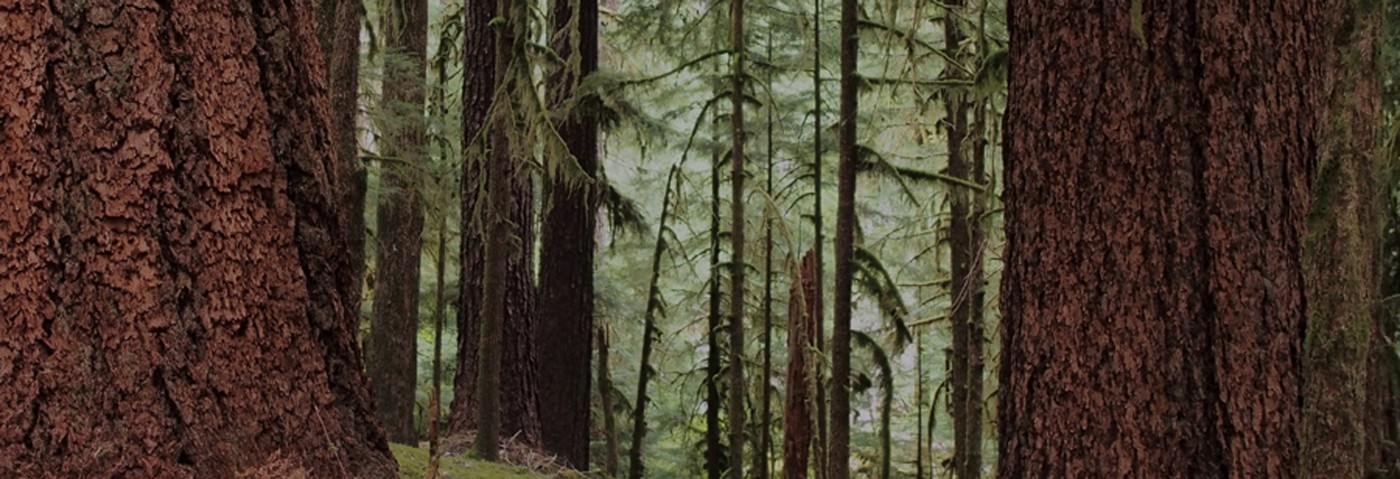
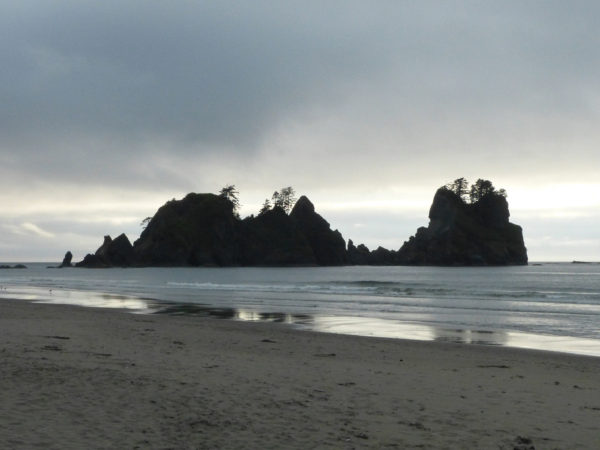
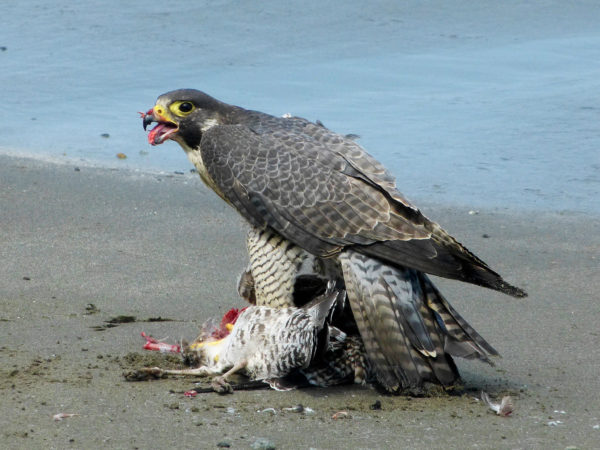
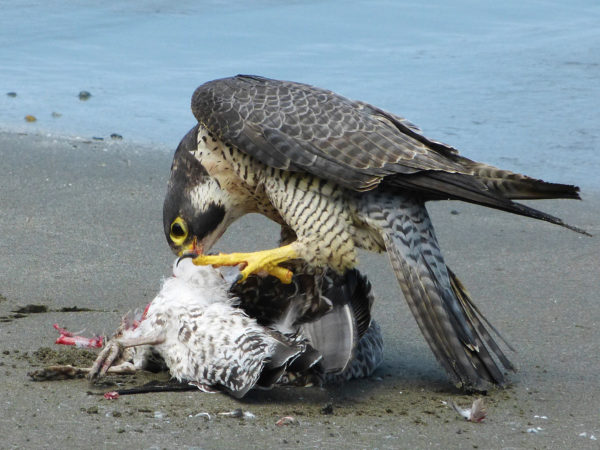
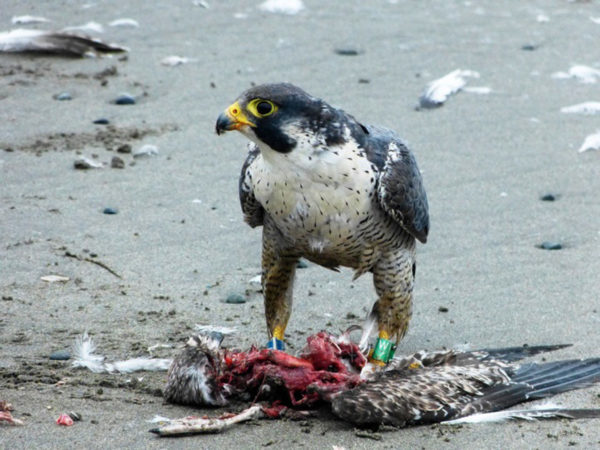
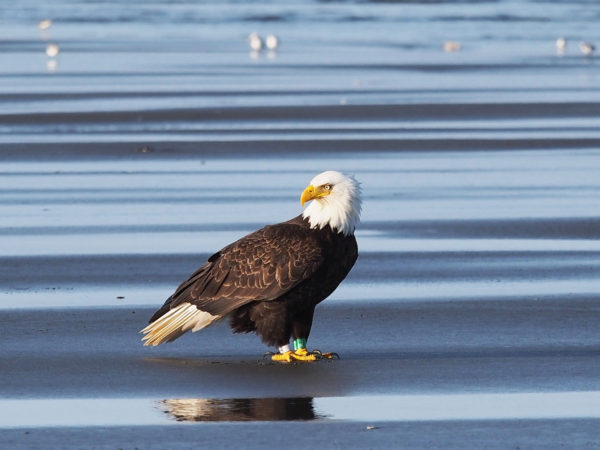
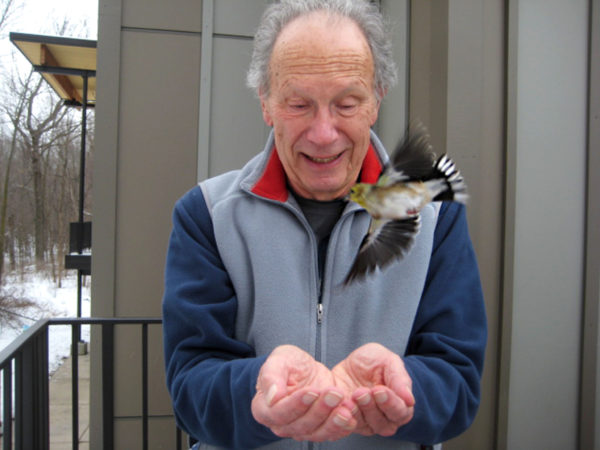
Beautifully written, Johnny! Thanks for sharing your experience with one of our most beloved banded birds, W/Z. Dan Varland
Thanks, Dan. W/Z made a deep impression on all of us, as did the unbanded Peregrine. It felt like being admitted into a private world!
Wonderful story and insights… Thanks..! And you’ve encouraged me to get to Shi-Shi —something that has been on my ‘list’ since we moved out here.. 😉 …been so close, but not quite.
You’ve also tweaked my curiosity about the raptor study group. We so much enjoy our local eagle family as they annually bring each new brood (1-2) to the perch nearby. Watching them train and just ‘hang’ with one another is a delight. We understand their nest is in Dash Point State Park a couple miles down the shore. Have hiked there but not spotted it.
Thanks again… And Regards, -Marty
Isn’t it great that raptors can be found even in urban environments? Do go to the Coastal Raptors web site. It is a rich one.
Beautiful story and gorgeous photos! Thanks for sharing, Johnny! Love the photo of you with the goldfinch!
Holding the goldfinch in my cupped hands and then watching him fly away was a real thrill!
Interesting for me, Johnny, that the same philosophical question of individual and species arises again in this reflection. Let me also express a sober delight in the graphic pictures of the falcon’s predatory acts, which is what raptors are designed to do: prey upon other life forms. Another Leibnizian theme: the distinction between natural and moral evil. Natural evil is the vulnerability that any conceivable creature is by nature exposed to. Moral evil is what human being fall prey to when they cannot accept their own natural vulnerability and try in ways that defy the ecology of things to secure their existence. Keep ’em coming!
Many thanks, Paul. I look forward to some in-person conversations one of these days!
This brings back memories of a similar scene on Orcas Island at Obstruction pass, where we watched two bald eagles cooperate to catch a low-flying gull. Interestingly, though, the one who actually caught it did not share with its partner in “natural crime.”
Thank you Johnny!
I love sharing experiences like this, Sylvaine!
Thanks Johnny for this vivid and instructive write-up. I was privileged to be there with you and the gang to see these events. One interesting aspect that will stick with me was that both times we only saw the aftermath. Despite being not many yards away, no body in our group of 20 witnessed the actual strike either time. (Apparently the gulls did not see W/Z coming either, although they did out up a good squawking fuss afterward.) These are very stealthy and quick predators!
They are indeed!
Thanks Johnny. I can still picture you taking the pictures while we were at Shi-Shi..It’s great to get the follow-up story on W/Z and hear of your experiences with “bird hypnosis” in Minnesota. It’s powerful to think how the world would be different if we humans would relate with other species as individuals.
Yes, the world surely would be different. I suspect that traditional cultures have more than a little to teach us in this area.
Thank you , Johnny! Your essay brought back wonderful memories of Shi Shi beach and also the years I spent banding manakins on Barro Colorado Island in Panama for my thesis. It was such a privilege to handle birds and get to know them individually.
Isn’t working with live organisms a whole different world from just reading about them?!
Nice to read about our Coastal Raptors group from another perspective. Such a wonderful experience in real life for children to see.
Coastal Raptors is a great organization! And yes, there’s nothing like direct experience.
Thanks dad for sharing this- we are really hoping to get to shi shi again next year- it’s been too long!!
Yea!